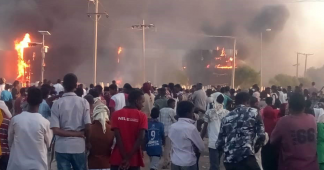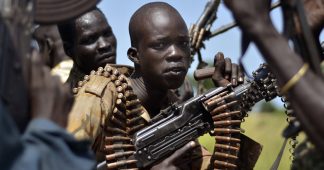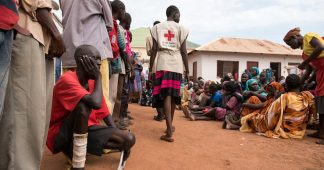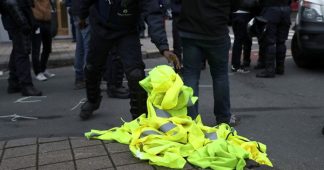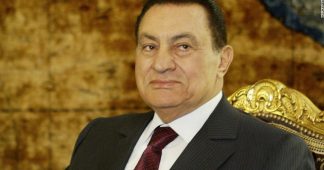The protests are spreading, and the Bashir dictatorship is being challenged as never before.
By Sara Mohammed
Jan.25, 2019
Since December 19, Sudan has been rocked by protests, which began in the historic center of the labor movement, the railway town of Atbara, and then spread throughout the country. The protesters are calling it a revolution. As with the Arab Spring of 2010 and 2011, the words “freedom” and “justice” are a constant rallying cry of the Sudanese demonstrators. But while many draw inspiration from the uprisings in neighboring countries like Egypt, the fuel for this one in Sudan is the country’s own history of civil disobedience, which overthrew two previous military regimes, in 1964 and 1985. The current protests are the most sustained popular challenge to the regime of Omar Hassan al-Bashir since he came to power 30 years ago.
Initially dubbed “bread riots” by the media, the protests have given expression to grievances that run much deeper than those arising from an economy seemingly in freefall. In Sudan, the Bashir regime is known simply as Inqaz (Salvation). The name was first used in 1989, when Bashir and his cohort of military officers, backed by the National Islamic Front, seized power in a coup d’état that they declared a “national salvation revolution.” Over the decades that followed, the Sudanese watched the country’s long and bloody civil war, which had raged since the early 1980s, spread from the south to Darfur and the Nuba Mountains in the west. Starting in 2009, the International Criminal Court issued warrants for the arrest of Bashir on multiple charges of genocide, war crimes, and crimes against humanity. The court has not been able to bring him into custody, however, despite his regular trips abroad.
While the members of the regime and those closely associated with them accumulated vast wealth, Bashir’s government went about dismantling the livelihoods of millions of people living in regions outside Khartoum. This was no innovation, but rather a highly efficient continuation of the British colonial and Sudanese postcolonial policy of treating regions like the south and Darfur as places that exist to subsidize the metropolis, which on its own produces little of value. The independence of South Sudan in 2011, joyously celebrated by the Southern Sudanese, who for decades had endured war, racism, and displacement by successive Khartoum governments, was experienced by many in the north as a painful loss, a trauma even.
With the oil-export economy emerging in the 1990s, other sectors that produced food and cash crops were left to wither away or were privatized and handed off to foreign investors or Inqaz loyalists. In particular, the dismantling of the Gezira Irrigation Scheme, a massive agricultural project situated between the banks of the Blue and White Niles south of Khartoum, has been the source of much popular discontent. Farmers driven off the land not just in Gezira but in other parts of the country, herders, laid-off workers, and those displaced by conflict moved to Khartoum in droves to eke out a living in miserable conditions. Others, considered fortunate by the rest, were forced to leave the country to try their luck in the Gulf countries or further afield.
By the mid-2000s the regime had become reliant on oil, so when South Sudan gained its independence and took with it the bulk of the oil sector, Sudan was plunged into a serious crisis. The government, strapped for cash, imposed austerity measures, including the removal of subsidies at the recommendation of the International Monetary Fund.
Since 2011, protests have sporadically erupted in Sudan, most notably in September 2013. In each case, they were brutally repressed. According to Amnesty International, in the first five days of the current uprising alone, 37 protesters were shot dead by security forces. Some of the dead and injured are children. The regime has sought to contain the demonstrations not only by deploying its notorious security squads, who travel in pickup trucks known as “thatchers,” but through mass arrests and by blocking access to the Internet. Journalists, academics, and especially doctors have been targeted, and hospitals have been attacked.
At the moment the protests continue unabated, and in fact seem to have both grown and spread geographically. They have also become better coordinated (an activist joked recently that the only thing the Sudanese, who are notoriously casual about appointments, show up for on time are the demonstrations). While the protests are sometimes described as leaderless, in the sense that no single political organization dominates them (with political parties in particular kept at arm’s length), they are arguably better described as shifting in leadership, depending on the day, the town, and even the neighborhood. One organization whose role has grown, particularly in Khartoum, is the Sudanese Professionals Association, which is lending strategy to the uprising with its calls for marches, strikes and targeted civil disobedience. The protesters have also used Friday prayers in local mosques as a platform from which to turn out people in large numbers.
In a joint statement, the United Kingdom, Norway, the United States, and Canada condemned the violence with which the protesters have been met, adding that “the Government of Sudan’s decisions over the coming weeks will have an impact on the engagement of our governments and others in the coming months and years.” It is unclear, however, whether they intend to act on that warning, given some of those countries’ geostrategic interests in the region. Since 2015, the European Union has allocated hundreds of millions of dollars to Sudan as part of a strategy to outsource migration control to third countries.
As for the United States, having already in 2017 eased sanctions on the country that date back to the Clinton era, the Trump administration removed Sudan from its list of countries targeted by the “Muslim ban.” As The Intercept reported at the time, this was due to lobbying by the United Arab Emirates, as a diplomatic favor to Bashir’s regime. It was a reward, so to speak, for putting boots on the ground in the Saudi-led (and US-backed) war in Yemen. Sudanese intervention in Yemen has been yet another cause of resentment among protesters, who feel that the regime has sold the country to the highest bidder to ensure its own survival.
While it is difficult to predict the outcome of this uprising, its energy and dynamism are undeniable. The relentless and constantly moving nature of the protests has made them difficult, thus far, to contain, not least of because they began outside Khartoum and then spread to the capital. This has proved disorienting for a regime already weakened by internal divisions and dwindling resources. Having concentrated its security apparatus in Khartoum, it has been ill-equipped to deal with those marching in cities such as Al-Gadarif, in eastern Sudan, or Dongola, in the far north of the country. In addition, the regime appears to have made a miscalculation by assuming that, since those towns are dead economically, they are also dead politically. It’s a lesson that gets repeated again and again, from France and the Gilets Jaunes to Sudan’s current protests—write off vast swaths of a country at your own peril.
In addition, the protests have assumed an anti-racist stance in rejecting the regime’s attempt to scapegoat Darfurians for the unrest. This has been met with a chant at demonstrations: “The whole country is Darfur!” In a region riven with ethnic tensions and hierarchies, this is one of the most hopeful signs of the uprising. It suggests the emergence of a new consciousness in a country that for too long has had trouble carving out an inclusive and cohesive national identity. For the protesters to prevail however, they would have to overcome tremendous odds. Then again, the regime has lost so much credibility in its three decades in power that it is hanging by its nails.
The elephant in the room is the question “What next?” But it is almost taboo to ask, as evidenced by one of the most popular slogans of the protesters, which translates roughly to: “[The regime] must fall: That’s all.” At the moment, activists both inside and outside Sudan are focused on inspiring the Sudanese people with the feeling that victory is not only possible but probable, should the country stand as one. They hope that this will encourage many to turn out for the protests, despite the real risk of injury, detention, or even death. This is working, as anger regarding indiscriminate killings by state security is spurring on the protests rather than dampening them. The cold-blooded murder of a young doctor, Babikir Abdelhamid, last week in Khartoum caused particular public outrage, leading to a major sit-in at a hospital in the area where he was treating the injured.
“What next?” is, however, one question that can’t be avoided, and in fact the regime has long tried to instill fear by suggesting that, should it fall, a scenario like that in Libya, Yemen, or even Syria awaits the country. This worry is real, given the proliferation of arms and militias in Sudan. But this has not deterred those marching and striking. When pressed, activists are dismissive: Things cannot continue as they are, they say; there is no going back. They are making an active choice to believe, to organize, to turn out, and to trust that, whether they succeed or fail in the short term, the seeds for a new, better Sudan have been sown.
Published at https://www.thenation.com/article/sudan-protests-revolution-bashir/
